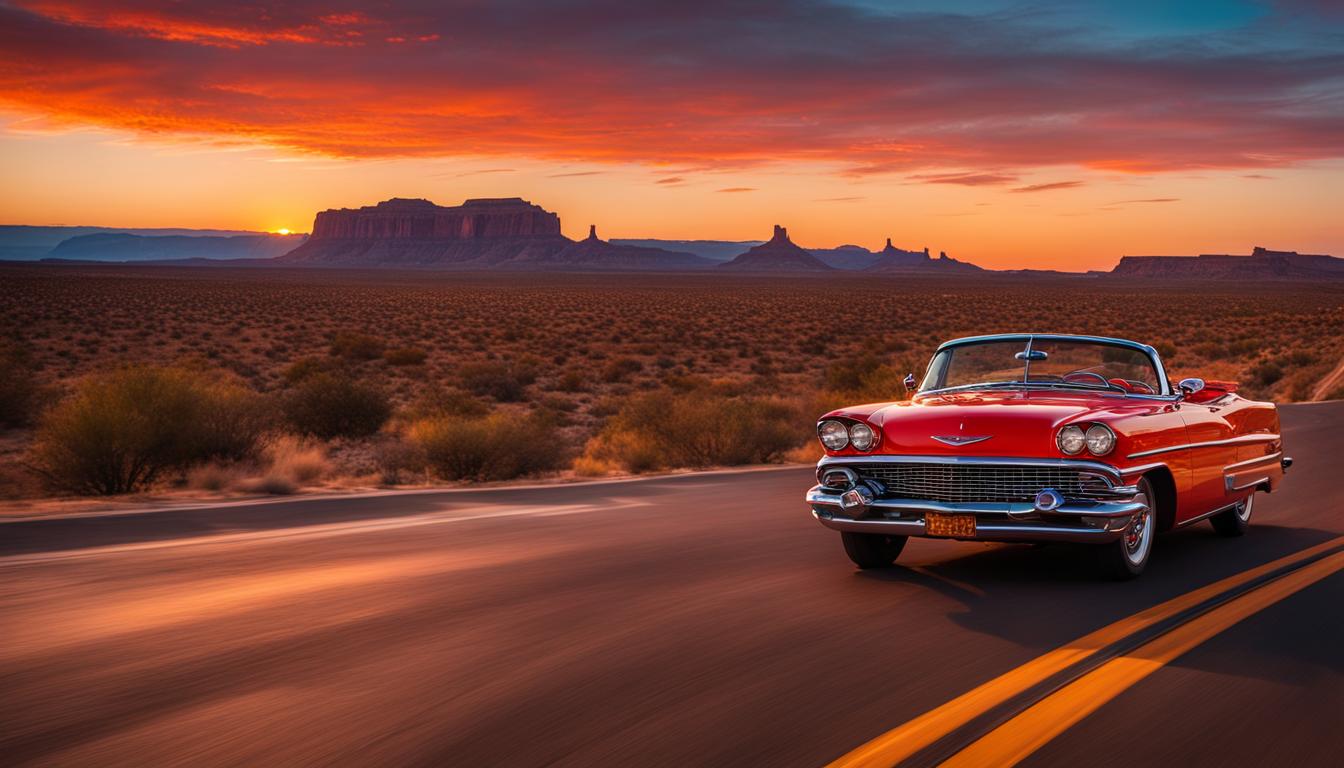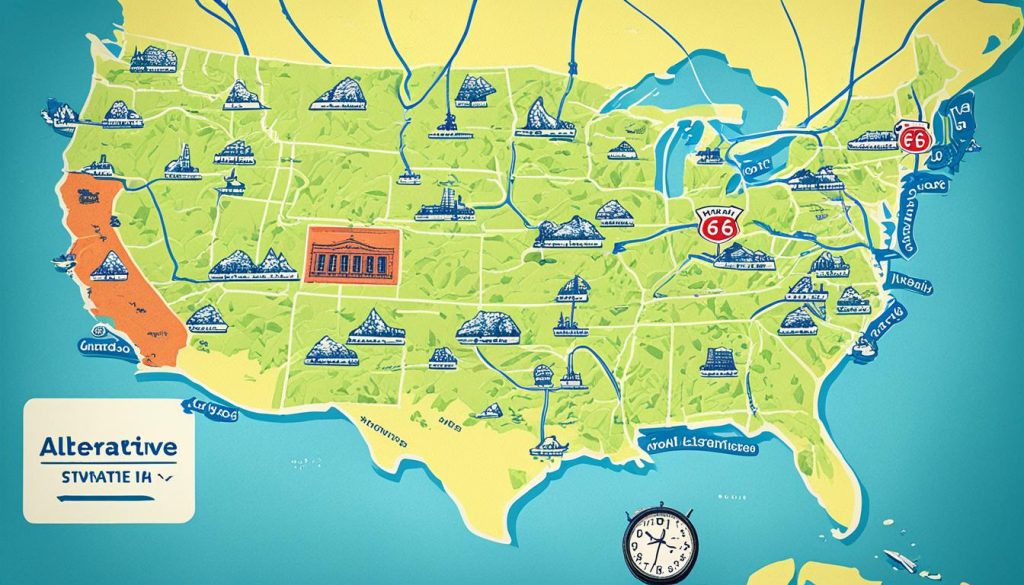
Travel Time on Route 66: Duration Explained
Traveling Route 66 is a bucket-list experience, but many people wonder how long it takes to complete the journey. The total length of Route 66 is 2,448 miles, stretching from Chicago to Santa Monica, California. However, the actual driving time will depend on various factors such as the number of stops, side trips, and the time spent exploring attractions along the way.
According to estimates, the total driving time without any stops is approximately 32-38 hours. However, it is recommended to take a more leisurely approach and plan for a minimum of 10 days to fully enjoy the Route 66 experience.
Key Takeaways:
- Route 66 is 2,448 miles long, spanning from Chicago to Santa Monica, California.
- The driving time without any stops is around 32-38 hours, but it is recommended to plan for a minimum of 10 days to fully experience the journey.
- The actual travel duration will depend on factors such as the number of stops, side trips, and time spent exploring attractions along the way.
- Take into account the weather conditions and plan your trip accordingly.
- Consider creating a well-planned itinerary and allowing for flexibility to make the most of your Route 66 adventure.
The Length of Route 66
Route 66, an iconic roadway that spans a distance of approximately 2,448 miles, offers an unforgettable journey from the bustling city streets of Chicago to the sunny shores of Santa Monica, California. It is important to note that the route has evolved over the years with new alignments, so the exact mileage may vary. This expansive length presents an exciting opportunity for travelers to immerse themselves in the rich history and vibrant culture of the towns and cities along the way.
The Diverse Landscapes of Route 66
As you traverse Route 66, you’ll encounter a diverse range of landscapes that showcase the stunning beauty of America. From the vibrant energy of Chicago to the picturesque deserts of the Southwest, each state along the route offers its own unique charm. Here’s a glimpse of the scenic wonders you can expect to experience:
| State | Landscapes |
|---|---|
| Illinois | Rolling fields and historic architecture |
| Missouri | Lush forests and the iconic Gateway Arch in St. Louis |
| Oklahoma | Wide-open plains and stunning sunsets |
| Texas | Charming small towns and vast expanses of land |
| New Mexico | Desert landscapes and Native American culture |
| Arizona | The dramatic vistas of the Grand Canyon and the iconic Route 66 signs |
| California | Spectacular coastal views and the allure of Santa Monica |
Each state along Route 66 offers its own unique attractions and hidden gems, making the journey an enriching experience for travelers.
Now, let’s move on to the next section and explore the driving time on Route 66.
Driving Time on Route 66
When embarking on a memorable road trip along Route 66, it’s essential to consider the driving time required to complete the journey. The duration of your drive will depend on several factors, including speed limits, traffic conditions, and the number of stops made along the way.
Assuming an average speed of 45 miles per hour, it would take approximately 50 hours and 37 minutes of continuous driving to complete the entire 2,448-mile route. This calculation provides a rough estimate of the driving time, but it’s important to note that it does not account for any stops made for rest, meals, or sightseeing.
To fully enjoy the Route 66 experience and make the most of your journey, it is highly recommended to plan for additional time. This will allow you to explore the numerous attractions, visit fascinating museums, and immerse yourself in the stunning scenic beauty found along the iconic route.
By taking the time to appreciate the roadside wonders, interact with friendly locals, and discover hidden gems, you can truly embrace the spirit of Route 66 and create memories that will last a lifetime.
Recommended Travel Time on Route 66
To fully appreciate the history and beauty of Route 66, it is recommended to plan for a minimum of 10 days for the trip from Chicago to Santa Monica. This allows for a more leisurely pace and the opportunity to explore attractions, stop at unique roadside diners, and take in the local culture. However, for a more extensive experience, many travelers opt to spend 14-21 days or longer on the journey. This extended time frame allows for side trips to iconic destinations like the Grand Canyon and flexibility to explore lesser-known attractions along the route.
By dedicating a sufficient amount of time to your Route 66 trip, you can truly immerse yourself in the nostalgia and charm of this iconic American highway. Whether you’re interested in exploring historical landmarks, admiring breathtaking landscapes, or indulging in regional cuisine, allowing for an ideal duration will ensure a more enriching and memorable experience.
So, whether you’re a history buff, an adventurous explorer, or simply seeking a scenic road trip, be sure to plan your Route 66 journey with ample time. Take the opportunity to create lasting memories as you traverse this legendary highway.
Best Time to Travel Route 66
The weather conditions along Route 66 can vary significantly depending on the time of year and the region. Spring and fall are generally considered the best seasons for a Route 66 trip, offering favorable weather and pleasant driving conditions.
In spring, from March to early June, the temperatures start to warm up, and the landscape comes alive with blooming flowers and vibrant colors. It’s an ideal time to explore Route 66, as you’ll enjoy comfortable temperatures, less traffic, and a refreshing ambiance.
In fall, from September to November, the weather is mild, and the foliage paints the route with beautiful autumn colors. It’s a popular time for travelers, as you can experience the magic of Route 66 while relishing the changing seasons.
However, it’s essential to be aware of the weather conditions in the specific regions along Route 66. Winter can bring challenging weather, including snowstorms and icy roads, which may affect your journey. Additionally, the summer months can be hot, particularly in the southwest desert areas, with temperatures often exceeding 100°F. It’s crucial to plan your trip accordingly, taking into account your preference for weather and any seasonal closures of businesses along the route.
| Season | Weather Conditions | Recommended Activities |
|---|---|---|
| Spring | Pleasant temperatures | Explore attractions, outdoor activities |
| Fall | Mild weather, beautiful foliage | Sightseeing, photography, enjoying the changing seasons |
| Winter | Possible snowstorms, icy roads | Plan for winter conditions, stay updated with weather forecasts |
| Summer | Hot temperatures in desert areas | Stay hydrated, plan for breaks in air-conditioned locations |
By considering the best time to travel Route 66, you can ensure a comfortable and enjoyable journey along this iconic road. Whether you choose to embrace the blossoming spring or the picturesque fall, your adventures on Route 66 will be filled with memorable experiences and breathtaking sights.
Stops and Attractions along Route 66
Route 66 is a legendary road that offers a plethora of attractions, must-see stops, and iconic landmarks. Embark on a journey filled with history, culture, and natural beauty. Explore vibrant cities like Chicago, where the route begins, and immerse yourself in its bustling streets and renowned architecture.
Continue your adventure to St. Louis, where the iconic Gateway Arch awaits, offering breathtaking views of the Mississippi River. Don’t miss the opportunity to visit Santa Fe, known for its charming adobe architecture, vibrant art scene, and rich Native American heritage.
One of the highlights of Route 66 is the Grand Canyon, a natural wonder that leaves visitors awe-inspired. Marvel at its vastness and stunning geological formations, creating a truly unforgettable experience.
As you journey along Route 66, make a stop at Cadillac Ranch, a unique art installation featuring a row of vintage Cadillacs buried nose-first in the ground. It’s a popular spot for creative expression and an excellent Instagram-worthy opportunity.
Take a step back in time at the Route 66 Museum in Oklahoma, showcasing the history, culture, and nostalgia of the iconic road. Learn about the people and stories that shaped Route 66 into the cultural icon it is today.
“Route 66 is a road of discovery, offering a myriad of attractions, from classic service stations and quirky roadside diners to stunning landscapes and charming vintage motels. It’s a journey that captures the essence of American culture and the spirit of exploration.”
Plan your itinerary in advance to ensure you have enough time to explore these must-see stops and discover hidden gems along the way. There’s no shortage of attractions that will captivate your senses and leave you with lasting memories of your Route 66 adventure.
| City/Attraction | Description |
|---|---|
| Chicago | Beginning of Route 66, vibrant city with architectural wonders |
| St. Louis | Gateway Arch, symbol of American expansion to the west |
| Santa Fe | Charming adobe architecture, vibrant art scene, and rich Native American heritage |
| Grand Canyon | Natural wonder, breathtaking views, and stunning geological formations |
| Cadillac Ranch | Art installation featuring vintage Cadillacs buried nose-first in the ground |
| Route 66 Museum (Oklahoma) | Showcasing the history, culture, and nostalgia of Route 66 |
Time Spent in Each State
Route 66, known as the “Main Street of America,” winds its way through eight different states, each offering its own unique attractions and sights to explore. The duration of your journey in each state will depend on the specific places you choose to visit along the route.
Some states, like Illinois and California, have longer stretches of Route 66, while others, such as Kansas and Texas, have shorter sections. To fully experience the offerings of each state and immerse yourself in the unique characteristics of every part of Route 66, it is important to allocate time accordingly.
Here’s a breakdown of the states that Route 66 passes through:
- Illinois
- Missouri
- Kansas
- Oklahoma
- Texas
- New Mexico
- Arizona
- California
As you plan your journey, consider the attractions and landmarks in each state that you don’t want to miss. Allocate enough time to fully explore the iconic sites, hidden gems, and local culture along the route for a truly unforgettable Route 66 experience.
Delve into the Unique Offerings of Each State
Route 66 offers a diverse range of experiences in each state it traverses. From the bustling streets of Chicago to the breathtaking landscapes of Arizona, every state along the route has its own charm and allure.
“The beauty of Route 66 lies in the variety of experiences it offers across different states. Each state has its own character, attractions, and stories to tell.” – Route 66 enthusiast
Immerse yourself in the vibrant culture of New Mexico’s Native American heritage, explore the historical landmarks in Missouri, or indulge in the mouthwatering cuisine of Texas. With each state comes a new chapter in your Route 66 journey.
Plan Your Time Wisely
To make the most of your time in each state, research the attractions and points of interest beforehand. Consider creating an itinerary that allows you to savor the highlights of each state along the way.
Here’s a suggested breakdown of the time you may want to allocate in each state:
| State | Recommended Time |
|---|---|
| Illinois | 2-3 days |
| Missouri | 1-2 days |
| Kansas | 1 day |
| Oklahoma | 2-3 days |
| Texas | 2-3 days |
| New Mexico | 2-3 days |
| Arizona | 2-3 days |
| California | 3-4 days |
Remember, these recommendations are flexible, and you can adjust your time in each state based on your interests and preferences. Be sure to leave enough room for unexpected discoveries and spontaneous detours along the way.
By allocating time wisely and immersing yourself in the unique offerings of each state, you’ll create lifelong memories and a truly memorable Route 66 adventure.
Side Trips and Detours
While the main route of Route 66 takes you on an incredible journey from Chicago to Santa Monica, there are also countless opportunities for side trips and detours along the way. These additional destinations allow you to explore even more of the diverse landscapes and cultures that the Southwest has to offer.
One of the most popular side trips from Route 66 is a scenic drive to the Grand Canyon. Located in Arizona, the Grand Canyon is one of the natural wonders of the world, with its breathtaking views and stunning rock formations. It’s an experience that should not be missed.
If you’re looking for something a little different, consider a visit to the vibrant city of Las Vegas. Known for its dazzling entertainment, world-class dining, and thrilling nightlife, Las Vegas offers a unique contrast to the historical charm of Route 66.
For those interested in Native American culture and art, a side trip to Monument Valley is a must. Located on the Arizona-Utah border, Monument Valley is famous for its towering sandstone formations, which have been featured in numerous films and iconic Western photographs.
If you’re heading towards the northeast, consider a detour to Santa Fe, New Mexico’s capital. This picturesque city offers a rich blend of Native American, Spanish, and Anglo cultures, with its adobe architecture and thriving art scene.
Another intriguing detour is Albuquerque, known for its vibrant hot air balloon festivals and its historic Old Town, which features adobe buildings and beautiful Spanish colonial architecture.
Including side trips and detours in your Route 66 itinerary will not only add extra time to your overall travel duration but also enhance the overall experience of your journey. It’s an opportunity to explore new destinations, discover unique attractions, and create unforgettable memories.
| Side Trip Destination | Description |
|---|---|
| Grand Canyon | A natural wonder with breathtaking views and stunning rock formations. |
| Las Vegas | A vibrant city known for its entertainment, dining, and nightlife. |
| Monument Valley | A destination famous for its towering sandstone formations and Native American culture. |
| Santa Fe | A picturesque city with a rich blend of Native American, Spanish, and Anglo cultures. |
| Albuquerque | A city known for its hot air balloon festivals and historic Old Town. |
These are just a few examples of the side trips and detours you can take along Route 66. Each destination offers its own unique charm and attractions, giving you the opportunity to create a personalized itinerary that matches your interests and preferences.

Factors Affecting Travel Time
When embarking on a journey along Route 66, several factors can influence the overall travel time. It’s important to consider these variables as they play a significant role in determining the duration of your adventure.
Number of Stops: The number of stops made along the route can greatly impact your travel time. Take into account the attractions, landmarks, and scenic viewpoints that pique your interest and allocate sufficient time to explore them.
Time Spent at Each Attraction: The amount of time you choose to spend at each attraction or stop can affect the overall duration of your journey. Some destinations may require more time for in-depth exploration, while others may be quick pit stops.
Speed Limits Along the Route: It’s essential to familiarize yourself with the speed limits on Route 66, as they can vary from one section to another. Adhering to the speed limits ensures a safe and legal journey, but it can also influence how quickly you reach your destination.
Weather Conditions: Weather conditions can be unpredictable, especially when traveling long distances. Keep an eye on the weather forecast along the route and make adjustments to your itinerary if necessary. Inclement weather, such as heavy rain or snowstorms, may slow down travel and require additional time for safety.
Detours, Side Trips, and Delays: Route 66 is full of hidden gems and nearby attractions that may tempt you to take detours or side trips. While these diversions enhance the overall experience, they can extend your travel time. Additionally, unexpected delays such as road closures or traffic congestion can also impact your journey.
By considering these factors and being flexible in your planning, you can make the most of your Route 66 adventure while ensuring a memorable and enjoyable travel experience.
| Factors | Impact |
|---|---|
| Number of Stops | Determines the length of time spent at various attractions along the route. |
| Time Spent at Each Attraction | Influences the overall duration of the journey based on the depth of exploration. |
| Speed Limits Along the Route | Affects how quickly you can reach your destination. |
| Weather Conditions | Can cause delays or require adjustments to ensure safe travel. |
| Detours, Side Trips, and Delays | Additional diversions or unforeseen circumstances that may extend travel time. |
Alternative Routes and Time Comparisons
While Route 66 is the iconic choice for a cross-country road trip, there are alternative routes available that may offer faster driving options. For example, driving on Interstates, such as I-40, can significantly reduce the travel time compared to following the winding path of Route 66. However, it is important to note that these alternative routes may bypass some of the unique attractions and historical landmarks along the original Route 66. Travelers should consider their priorities and preferences when deciding between the faster but less scenic options and the slower, more immersive experience of the traditional Route 66 route.
| Route | Driving Time | Attractions Bypassed |
|---|---|---|
| Route 66 (Original) | Approximately 32-38 hours | Various iconic stops and historical landmarks |
| Interstate (e.g., I-40) | Approximately 27-32 hours | Some unique attractions and scenic spots |
If you’re looking to cover more ground in less time and prioritize efficiency, an alternative interstate route like I-40 might be a suitable choice. It offers faster driving options, reducing your overall travel time on the road. However, be aware that by opting for the interstate, you may miss out on the chance to visit specific Route 66 attractions that contribute to its cultural and historical significance.
To make an informed decision, consider your travel goals and interests. If you’re primarily seeking a quick journey, the interstate route may be preferable. However, if you value a more immersive experience, taking the traditional Route 66 allows you to fully appreciate its distinctive charm, explore iconic landmarks, and soak in the nostalgia of the historic road. Ultimately, it’s about finding the right balance between efficiency and experiencing the true essence of Route 66.

Recommended Itineraries
Planning an itinerary for your Route 66 trip can be exciting and challenging. To help you get started, here are a few sample itineraries based on different timeframes:
- 10 days: Starting in Chicago and ending in Santa Monica, this itinerary allows for a focused trip with limited side trips.
- 14 days: This extended itinerary allows for a more relaxed pace and additional time for side trips and detours to popular destinations.
- 21 days or longer: For a comprehensive exploration of Route 66 and the surrounding areas, consider a longer itinerary that includes multiple side trips, extra time in major cities, and the flexibility to discover lesser-known attractions.
Remember to customize your itinerary based on your personal interests, desired attractions, and available time, ensuring a memorable and enjoyable Route 66 experience.
10-Day Itinerary
Brief Description:
- Day 1: Start in Chicago, explore the city, and visit Route 66 beginning point at Grant Park.
- Day 2: Drive to St. Louis, visit the Gateway Arch and explore the city’s attractions.
- Day 3: Travel to Springfield, Illinois, and visit the Abraham Lincoln Presidential Library and Museum.
- Day 4: Drive to Oklahoma City, visit the National Cowboy & Western Heritage Museum and the Oklahoma City National Memorial.
- Day 5: Explore Amarillo, Texas, and visit Cadillac Ranch and the American Quarter Horse Hall of Fame.
- Day 6: Drive to Santa Fe, New Mexico, and explore the Santa Fe Plaza and the Georgia O’Keeffe Museum.
- Day 7: Visit the Petrified Forest National Park and spend the night in Flagstaff, Arizona.
- Day 8: Travel to the Grand Canyon National Park and spend the day exploring the breathtaking views.
- Day 9: Drive to Las Vegas, Nevada, and enjoy the entertainment and attractions of the famous Las Vegas Strip.
- Day 10: Finish the journey in Santa Monica, California, and visit the iconic Santa Monica Pier.
14-Day Itinerary
Brief Description:
- Days 1-4: Follow the 10-day itinerary.
- Day 5: Drive to Albuquerque, New Mexico, and explore the historic Old Town and the Indian Pueblo Cultural Center.
- Day 6: Visit the Acoma Pueblo and then continue to Gallup, New Mexico.
- Day 7: Drive to Holbrook, Arizona, and visit the Wigwam Motel and the Historic Route 66 Bridge.
- Day 8: Explore the Painted Desert and the Meteor Crater, then spend the night in Winslow, Arizona.
- Day 9: Visit the Walnut Canyon National Monument and spend the night in Flagstaff, Arizona.
- Day 10: Drive to Kingman, Arizona, and explore the Historic Route 66 Museum and the Powerhouse Visitors Center.
- Day 11: Travel to the Mojave Desert and spend the night in Barstow, California.
- Day 12: Visit the Calico Ghost Town and continue to San Bernardino, California.
- Day 13: Drive to Los Angeles, California, and explore the city’s famous landmarks.
- Day 14: Finish the journey in Santa Monica, California, and visit the iconic Santa Monica Pier.
21-Day or Longer Itinerary
Brief Description:
- Days 1-8: Follow the 14-day itinerary.
- Day 9: Explore Joshua Tree National Park, then continue to Palm Springs, California.
- Days 10-12: Discover the beauty of San Diego, California, and its attractions.
- Day 13: Drive to Anaheim, California, and visit Disneyland Park.
- Days 14-16: Explore the stunning landscapes of the Grand Canyon, including the North and South Rims.
- Day 17: Visit Monument Valley, Utah, and experience the iconic red rock formations.
- Day 18: Explore the unique landscapes of Bryce Canyon National Park.
- Day 19: Drive to Zion National Park and hike through its majestic canyons.
- Day 20: Visit the Hoover Dam and then continue to Las Vegas, Nevada, for a night of entertainment.
- Day 21: Finish the journey in Santa Monica, California, and visit the iconic Santa Monica Pier.
These itineraries are just a starting point, and you can modify them to fit your preferences and available time. Enjoy your Route 66 adventure!
Planning Tips for a Route 66 Trip
Embarking on a Route 66 adventure is an exciting endeavor, and proper planning can make your journey even more enjoyable. Consider the following tips to ensure a smooth and memorable experience:
- Research and map out the attractions, stops, and accommodations along the route in advance. By doing your homework and identifying the must-visit sites and accommodations ahead of time, you can make the most of your time on Route 66. Look for unique attractions, historical landmarks, and charming establishments where you can experience the local culture.
- Allow for flexibility in your itinerary to account for unexpected detours or additional attractions you discover along the way. While it’s important to have a general roadmap, be open to spontaneous detours and new discoveries. Some of the best experiences on Route 66 can be found off the beaten path. Leave room in your schedule to explore hidden gems and unexpected surprises.
- Pack essential items such as a road atlas, travel guides, comfortable clothing, and snacks. A road atlas will come in handy if you encounter areas with poor GPS or cell phone reception. Travel guides specific to Route 66 can provide valuable insights and recommendations for attractions, dining options, and accommodations. Comfortable clothing, including appropriate footwear, will ensure you can fully enjoy the diverse landscapes and climates along the route. And don’t forget to bring snacks for those stretches of road where dining options may be limited.
- Check the weather conditions for each region you will be traveling through and plan accordingly. Route 66 covers a wide range of climates, from the hot desert to the cooler northern regions. Be prepared for varying weather conditions by checking the forecast for each area you plan to visit. Pack accordingly with layers, sunscreen, hats, and any other necessary gear to ensure your comfort and safety throughout the trip.
- Have a contingency plan for unexpected situations, such as vehicle breakdowns or delays. While we hope for a smooth journey, it’s always wise to have a backup plan in case of unforeseen circumstances. Familiarize yourself with local mechanics and towing services along the route, and ensure you have a contact list with emergency numbers. Consider purchasing travel insurance that covers roadside assistance and trip interruption to provide peace of mind.
- Take advantage of resources like guidebooks and online forums to gather insights and recommendations from experienced Route 66 travelers. Many road trip enthusiasts have traveled Route 66 before and are eager to share their experiences and tips. Guidebooks and online forums dedicated to Route 66 can provide valuable insights and recommendations on attractions, accommodations, and local businesses. Engaging with fellow travelers can enhance your journey by uncovering hidden gems and insider knowledge.
By following these planning tips, you’ll be well-prepared for an unforgettable Route 66 journey filled with iconic sights, rich history, and unforgettable moments.
Conclusion
Embarking on a journey along Route 66 is an extraordinary way to immerse yourself in the captivating history and remarkable landscapes of the United States. The length of your Route 66 trip will vary based on your personal preferences, available time, and desired experiences. Whether you opt for the complete route or choose to focus on specific sections, it is crucial to allocate sufficient time for exploring and unwinding along the way.
By crafting a well-thought-out itinerary, considering weather conditions, and embracing flexibility, you can embark on a memorable adventure that truly reflects the essence of Route 66. From the bustling streets of Chicago to the sunny shores of Santa Monica, Route 66 offers an array of awe-inspiring attractions and hidden gems waiting to be discovered.
As you travel, take the opportunity to savor the diverse cultures, visit roadside diners, and marvel at the iconic landmarks that dot the route. Remember, the journey is as important as the destinations themselves. Allow yourself the time to create lasting memories, meet fascinating people, and connect with the rich tapestry of American history that Route 66 embodies.


Average Rating